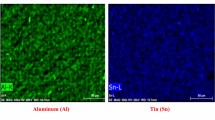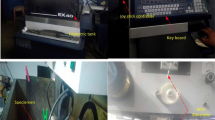Abstract
Wire electrical discharge machining (WEDM) is one of the efficient technologies of unconventional machining used to construct complex shape components, of hard materials or non-ferrous metals such as aluminum alloys. Qualitative assessment of wire electrical discharge machining (WEDM) of 2017T451 and 7075T651 aluminum alloys in terms of surface finish is studied. Three-factor and 3-level WEDM trials are operated by an L9 Taguchi’s orthogonal array to determine the influence of process parameters. Based on surface roughness (Ra) value, the signal-to-noise (S/N) ratio and analysis of variance (ANOVA) results reveal that the pulse on time (TON) and pulse off time (TOFF) are significant cutting parameters affecting the surface roughness (Ra). Surface topography of the treated materials shows that no cracks for the two aluminum alloys are considered in this work.


























Similar content being viewed by others
References
Starke EA Jr, Staley JT (1996) Application of modern aluminum alloys to aircraft. Prog Aerosp Sci 32(2–3):131–172. https://doi.org/10.1016/0376-0421(95)00004-6
Mondolfo LF (2013) Aluminum alloys: structure and properties. Elsevier
Di S, Huang R, Chi G (2006) Study on micro-machining by micro-WEDM. In 2006 1st IEEE international conference on nano/micro engineered and molecular systems (pp. 615–619) IEEE. https://doi.org/10.1109/NEMS.2006.334857
Sivaprakasam P, Hariharan P, Gowri S (2014) Modeling and analysis of micro-WEDM process of titanium alloy (Ti–6Al–4V) using response surface approach. Eng Sci Technol Int J 17(4):227–235. https://doi.org/10.1016/j.jestch.2014.06.004
Ho KH, Newman ST, Rahimifard S, Allen RD (2004) State of the art in wire electrical discharge machining (WEDM). Int J Mach Tools Manuf 44(12–13):1247–1259. https://doi.org/10.1016/j.ijmachtools.2004.04.017
Klocke F, Hensgen L, Klink A, Ehle L, Schwedt A (2016) Structure and composition of the white layer in the wire-EDM process. Procedia CIRP 42:673–678. https://doi.org/10.1016/j.procir.2016.02.300
Bobbili R, Madhu V, Gogia AK (2013) Effect of wire-EDM machining parameters on surface roughness and material removal rate of high strength armor steel. Mater Manuf Processes 28(4):364–368. https://doi.org/10.1080/10426914.2012.736661
Gorji N E, O'Connor R, Brabazon D (2021) XPS and SEM characterization for powder recycling within 3d printing process. 24th International Conference on Material Forming. ESAFORM 2021. MS13 (Additive Manufacturing). https://doi.org/10.25518/ESAFORM21.403
Veeresh M, Raju GS, Saju KK, Rajaprakash BM (2019) Optimization of wire EDM machining parameters for optimum materials removal rate and surface finish in an aluminum 7075–T651 alloy. IJERT -ISSN 2278:0181
Selvakumar G, Sornalatha G, Sarkar S, Mitra S (2014) Experimental investigation and multiobjective optimization of wire electrical discharge machining (WEDM) of 5083 aluminum alloy. Trans Nonferrous Metals Soc China 24(2):373–379. https://doi.org/10.1016/S1003-6326(14)63071-5
Mandal K, Bose D, Mitra S, Sarkar S (2020) Experimental investigation of process parameters in WEDM of Al 7075 alloy. Manuf Rev 7:30. https://doi.org/10.1051/mfreview/2020021
Tzeng YF, Chen FC (2003) A simple approach for robust design of high-speed electrical discharge machining technology. Int J Mach Tools Manuf 43(3):217–227. https://doi.org/10.1016/S0890-6955(02)00261-4
Simao J, Lee HG, Aspinwall DK, Dewes RC, Aspinwall EM (2003) Workpiece surface modification using electrical discharge machining. Int J Mach Tools Manuf 43(2):121–128. https://doi.org/10.1016/S0890-6955(02)00187-6
Chen DC, Jhang JJ, Guo MW (2013) Application of Taguchi design method to optimize the electrical discharge machining. J Achiev Mater Manuf Eng 57(2):76–82
Selvakumar G, Sornalatha G, Sarkar S, Mitra S (2014) Experimental investigation and multi objective optimization of wire electrical discharge machining (WEDM) of 5083 aluminum alloy. Trans Nonferrous Metals Soc China 24(2):373–379. https://doi.org/10.1016/S1003-6326(14)63071-5
Bagal GS, Karvande RL, Irfan M (2021) Process parameter optimization in wire cut EDM: a review. IJARIIE - ISSN 2395:4396–4397
Kamble N, Jadhav A (2020) A review on machining parameters and optimization of wire EDM process. IRJET -ISSN 2395:0056–0057
Mouralova K, Kovar J, Klakurkova L, Bednar J, Benes L, Zahradnicek R (2018) Analysis of surface morphology and topography of pure aluminium machined using WEDM. Measurement 114:169–176. https://doi.org/10.1016/j.measurement.2017.09.040
Rao PS, Ramji K, Satyanarayana B (2014) Experimental investigation and optimization of wire EDM parameters for surface roughness, MRR and white layer in machining of aluminium alloy. Procedia Mater Sci 5:2197–2206. https://doi.org/10.1016/j.mspro.2014.07.426
Dave HK, Mathai VJ, Desai KP, Raval HK (2015) Studies on quality of microholes generated on Al 1100 using micro-electro-discharge machining process. Int J Adv Manuf Technol 76(1):127–140
Roy RK (2001) Design of experiments using the Taguchi approach: 16 steps to product and process improvement. John Wiley & Sons
Kumar S, Kumar P, Shan HS (2008) Optimization of tensile properties of evaporative pattern casting process through Taguchi’s method. J Mater Process Technol 204(1–3):59–69. https://doi.org/10.1016/j.jmatprotec.2007.10.075
Suhail AH, Ismail N, Wong SV, Abdul Jalil NA (2010) Optimization of cutting parameters based on surface roughness and assistance of workpiece surface temperature in turning process. AmJEngApplSci 102:108–113. https://doi.org/10.3844/ajeassp.2010.102.108
Guu YH (2005) AFM surface imaging of AISI D2 tool steel machined by the EDM process. Appl Surf Sci 242(3–4):245–250. https://doi.org/10.1016/j.apsusc.2004.08.028
Mandaloi G, Singh S, Kumar P, Pal K (2016) Effect on crystalline structure of AISI M2 steel using tungsten–thorium electrode through MRR, EWR, and surface finish. Measurement 90:74–84. https://doi.org/10.1016/j.measurement.2016.04.041
Muhammad A, Mirza J, Abbasi JA, Musharaf A, Ahmad W, Salman H (2016) Parametric analysis of recast layer formation in wire-cut EDM of HSLA steel. Int J Adv Manuf Technol 87(1–4):713–722. https://doi.org/10.1007/s00170-016-8518-3
Gostimirovic M, Kovac P, Sekulic M, Skoric B (2012) Influence of discharge energy on machining characteristics in EDM. J Mech Sci Technol 26(1):173–179
Tai TY, Lu SJ (2009) Improving the fatigue life of electro-discharge-machined SDK11 tool steel via the suppression of surface cracks. Int J Fatigue 31(3):433–438. https://doi.org/10.1016/j.ijfatigue.2008.07.013
Funding
The authors declare that no funds, grants, or other support were received during the preparation of this manuscript.
Author information
Authors and Affiliations
Contributions
Dorra Hammami: writing—original draft preparation, data collection, and formal analysis. Sana Louati: writing, material preparation, data collection, and analysis. Neila Masmoudi: reviewing, methodology, investigation, visualization, and validation. Chedly Bradai: supervision and validation.
Corresponding author
Ethics declarations
Ethics approval
Authors confirm that the submitted work is original, and it have not been published elsewhere in any form or language.
Conflict of interest
The authors declare no competing interests.
Data assessment
All the concerned data have already been contained in the paper.
Additional information
Publisher's note
Springer Nature remains neutral with regard to jurisdictional claims in published maps and institutional affiliations.
Rights and permissions
Springer Nature or its licensor (e.g. a society or other partner) holds exclusive rights to this article under a publishing agreement with the author(s) or other rightsholder(s); author self-archiving of the accepted manuscript version of this article is solely governed by the terms of such publishing agreement and applicable law.
About this article
Cite this article
Hammami, D., Louati, S., Masmoudi, N. et al. Influence of WEDM process parameters on aluminum alloy’s surface finish. Int J Adv Manuf Technol 126, 453–469 (2023). https://doi.org/10.1007/s00170-023-10929-w
Received:
Accepted:
Published:
Issue Date:
DOI: https://doi.org/10.1007/s00170-023-10929-w




